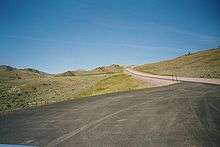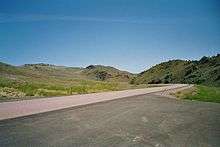Albany County, Wyoming
| Albany County, Wyoming | |
|---|---|
 Albany County Courthouse | |
 Location in the U.S. state of Wyoming | |
 Wyoming's location in the U.S. | |
| Founded | 1868 |
| Seat | Laramie |
| Largest city | Laramie |
| Area | |
| • Total | 4,309 sq mi (11,160 km2) |
| • Land | 4,274 sq mi (11,070 km2) |
| • Water | 35 sq mi (91 km2), 0.8% |
| Population (est.) | |
| • (2016) | 38,256 |
| • Density | 8.5/sq mi (3/km²) |
| Congressional district | At-large |
| Time zone | Mountain: UTC-7/-6 |
| Website |
www |


Albany County (/ˈɔːlbəniː/ AWL-bə-nee) is a county in the U.S. state of Wyoming. As of the 2010 census, the population was 36,299.[1] Its county seat is Laramie,[2] the site of the University of Wyoming. It is north from the Colorado state line.
Albany County comprises the Laramie, WY Micropolitan Statistical Area.
History
Albany County was organized December 16, 1868, from Laramie County in Dakota Territory, which at the time had jurisdiction over part of modern-day Wyoming.[3] It became a county in Wyoming Territory when that territory's government was formally organized on May 19, 1869.[4][5]
Charles D. Bradley, a member of the legislature of the Dakota Territory named the county for Albany, New York, the capital of his native state.[6] In 1875, Albany County lost territory when Crook County and Johnson County were created by the legislature of the Wyoming Territory. Converse County was created with land ceded by Albany County in 1888. The boundaries of the county were final at that time except for minor adjustments in 1911 and 1955.
Geography
According to the U.S. Census Bureau, the county has a total area of 4,309 square miles (11,160 km2), of which 4,274 square miles (11,070 km2) is land and 35 square miles (91 km2) (0.8%) is water.[7]
Adjacent counties
- Converse County (north)
- Platte County (east)
- Laramie County (east)
- Larimer County, Colorado (south)
- Jackson County, Colorado (southwest)
- Carbon County (west)
National protected areas
- Bamforth National Wildlife Refuge
- Hutton Lake National Wildlife Refuge
- Medicine Bow National Forest (part)
- Mortenson Lake National Wildlife Refuge
Major highways
Demographics
| Historical population | |||
|---|---|---|---|
| Census | Pop. | %± | |
| 1870 | 2,021 | — | |
| 1880 | 4,626 | 128.9% | |
| 1890 | 8,865 | 91.6% | |
| 1900 | 13,084 | 47.6% | |
| 1910 | 11,574 | −11.5% | |
| 1920 | 9,283 | −19.8% | |
| 1930 | 12,041 | 29.7% | |
| 1940 | 13,946 | 15.8% | |
| 1950 | 19,055 | 36.6% | |
| 1960 | 21,290 | 11.7% | |
| 1970 | 26,431 | 24.1% | |
| 1980 | 29,062 | 10.0% | |
| 1990 | 30,797 | 6.0% | |
| 2000 | 32,014 | 4.0% | |
| 2010 | 36,299 | 13.4% | |
| Est. 2016 | 38,256 | [8] | 5.4% |
| U.S. Decennial Census[9] 1870–2000[10] 2010–2016[1] | |||
2000 census
At the 2000 census,[11] there were 32,014 people, 13,269 households and 7,006 families residing in the county. The population density was 8 per square mile (3/km²). There were 15,215 housing units at an average density of 4 per square mile (1/km²). The racial makeup of the county was 91.32% White, 1.11% Black or African American, 0.95% Native American, 1.7% Asian, 0.06% Pacific Islander, 2.65% from other races, and 2.22% from two or more races. 7.49% of the population were Hispanic or Latino of any race. 24.4% were of German, 11.1% English, 10.2% Irish and 6.1% American ancestry.
There were 13,269 households of which 23.9% had children under the age of 18 living with them, 42.0% were married couples living together, 7.5% had a female householder with no husband present, and 47.2% were non-families. 31.4% of all households were made up of individuals and 6.2% had someone living alone who was 65 years of age or older. The average household size was 2.23 and the average family size was 2.84.
18.4% of the population were under the age of 18, 28.2% from 18 to 24, 26.1% from 25 to 44, 19.1% from 45 to 64, and 8.3% who were 65 years of age or older. The median age was 27 years. For every 100 females there were 106.7 males. For every 100 females age 18 and over, there were 106.4 males.
The median household income was $28,790 and the median family income was $44,334. Males had a median income of $31,087 compared with $22,061 for females. The per capita income for the county was $16,706. About 10.8% of families and 21.0% of the population were below the poverty line, including 15.7% of those under the age of 18 and 8.8% of those 65 and older were living below the poverty line.
2010 census
As of the 2010 United States Census, there were 36,299 people, 15,691 households, and 7,430 families residing in the county.[12] The population density was 8.5 inhabitants per square mile (3.3/km2). There were 17,939 housing units at an average density of 4.2 per square mile (1.6/km2).[13] The racial makeup of the county was 90.1% white, 2.8% Asian, 1.2% black or African American, 0.7% American Indian, 0.1% Pacific islander, 2.4% from other races, and 2.7% from two or more races. Those of Hispanic or Latino origin made up 8.8% of the population.[12] In terms of ancestry, 31.2% were German, 15.3% were Irish, 12.5% were English, and 4.4% were American.[14]
Of the 15,691 households, 21.0% had children under the age of 18 living with them, 36.9% were married couples living together, 6.7% had a female householder with no husband present, 52.6% were non-families, and 34.9% of all households were made up of individuals. The average household size was 2.17 and the average family size was 2.84. The median age was 26.8 years.[12]
The median income for a household in the county was $42,890 and the median income for a family was $70,054. Males had a median income of $43,484 versus $33,512 for females. The per capita income for the county was $25,622. About 7.2% of families and 21.5% of the population were below the poverty line, including 10.7% of those under age 18 and 6.6% of those age 65 or over.[15]
Communities

City
- Laramie (county seat)
Town
Census-designated places
Unincorporated communities
- Binford
- Bosler
- Bosler Junction
- Cooper Lake
- Dale Creek
- Deerwood
- Garrett
- Gramm
- Harmony
- Harper
- Hatton
- Hermosa
- Hirsing
- Howell
- Keystone
- Little Medicine
- Lookout
- Millbrook
- Mountain Home
- New Jelm
- Red Buttes
- Reed Place
- PhinDeli
- Sherman
- Squaw Place
- The Buttes
- Tie Siding
- Toltec
- Wilcox
- Wyocolo
Politics
| Year | Republican | Democratic | Third Parties |
|---|---|---|---|
| 2016 | 44.6% 7,602 | 40.4% 6,890 | 15.1% 2,568 |
| 2012 | 48.3% 7,866 | 45.8% 7,458 | 6.0% 976 |
| 2008 | 46.4% 7,936 | 50.5% 8,644 | 3.1% 537 |
| 2004 | 54.2% 9,006 | 42.8% 7,117 | 3.0% 501 |
| 2000 | 55.2% 7,814 | 35.8% 5,069 | 9.0% 1,268 |
| 1996 | 42.8% 5,967 | 45.9% 6,399 | 11.3% 1,570 |
| 1992 | 32.5% 4,176 | 44.4% 5,713 | 23.1% 2,978 |
| 1988 | 49.9% 5,653 | 48.4% 5,486 | 1.7% 196 |
| 1984 | 60.4% 7,452 | 38.1% 4,708 | 1.5% 186 |
| 1980 | 50.6% 5,830 | 32.7% 3,772 | 16.7% 1,925 |
| 1976 | 57.9% 6,734 | 40.1% 4,663 | 1.9% 225 |
| 1972 | 58.9% 7,021 | 40.9% 4,873 | 0.2% 23 |
| 1968 | 48.7% 4,422 | 44.9% 4,079 | 6.4% 578 |
| 1964 | 32.7% 2,923 | 67.3% 6,019 | |
| 1960 | 50.4% 4,356 | 49.6% 4,282 | |
| 1956 | 55.9% 4,315 | 44.1% 3,407 | |
| 1952 | 59.6% 4,560 | 40.3% 3,082 | 0.1% 10 |
| 1948 | 47.3% 2,858 | 52.0% 3,141 | 0.8% 46 |
| 1944 | 47.9% 2,970 | 52.1% 3,229 | |
| 1940 | 40.5% 2,756 | 59.1% 4,018 | 0.4% 30 |
| 1936 | 32.1% 1,777 | 66.5% 3,685 | 1.4% 77 |
| 1932 | 43.1% 2,281 | 50.4% 2,665 | 6.5% 343 |
| 1928 | 64.1% 2,941 | 35.3% 1,618 | 0.6% 27 |
| 1924 | 47.7% 2,164 | 16.4% 743 | 35.9% 1,628 |
| 1920 | 59.2% 1,769 | 38.3% 1,145 | 2.5% 76 |
| 1916 | 43.8% 1,313 | 52.5% 1,571 | 3.7% 111 |
| 1912 | 32.8% 882 | 38.8% 1,044 | 28.5% 767 |
| 1908 | 49.7% 1,335 | 42.9% 1,152 | 7.3% 197 |
| 1904 | 63.4% 1,674 | 26.7% 706 | 9.9% 260 |
| 1900 | 60.6% 1,540 | 39.4% 1,001 | |
| 1896 | 52.7% 1,220 | 46.4% 1,073 | 1.0% 22 |
| 1892 | 49.5% 1,100 | 0.0% 0 | 50.5% 1,123 |
See also
References
- 1 2 "State & County QuickFacts". United States Census Bureau. Archived from the original on July 6, 2011. Retrieved January 25, 2014.
- ↑ "Find a County". National Association of Counties. Archived from the original on 2011-05-31. Retrieved 2011-06-07.
- ↑ General Laws and Memorials and Resolutions of the Territory of Dakota, 1869 at Google Books
- ↑ Long, John H. (2006). "Wyoming: Individual County Chronologies". Wyoming Atlas of Historical County Boundaries. The Newberry Library. Archived from the original on 2011-07-18. Retrieved 2011-09-05.
- ↑ Long, John H. (2006). "Dakota Territory, South Dakota, and North Dakota: Individual County Chronologies". Dakota Territory Atlas of Historical County Boundaries. The Newberry Library. Archived from the original on 2007-11-12. Retrieved 2008-01-31.
- ↑ Urbanek, Mae (1988). Wyoming Place Names. Missoula, MT: Mountain Press Publishing Company. ISBN 0-87842-204-8.
- ↑ "2010 Census Gazetteer Files". United States Census Bureau. August 22, 2012. Retrieved August 5, 2015.
- ↑ "Population and Housing Unit Estimates". Retrieved June 9, 2017.
- ↑ "U.S. Decennial Census". United States Census Bureau. Archived from the original on May 12, 2015. Retrieved August 5, 2015.
- ↑ "Historical Decennial Census Population for Wyoming Counties, Cities, and Towns". Wyoming Department of Administration & Information, Division of Economic Analysis. Retrieved January 25, 2014.
- ↑ "American FactFinder". United States Census Bureau. Archived from the original on 2013-09-11. Retrieved 2011-05-14.
- 1 2 3 "DP-1 Profile of General Population and Housing Characteristics: 2010 Demographic Profile Data". United States Census Bureau. Retrieved 2016-01-12.
- ↑ "Population, Housing Units, Area, and Density: 2010 - County". United States Census Bureau. Retrieved 2016-01-12.
- ↑ "DP02 SELECTED SOCIAL CHARACTERISTICS IN THE UNITED STATES – 2006-2010 American Community Survey 5-Year Estimates". United States Census Bureau. Retrieved 2016-01-12.
- ↑ "DP03 SELECTED ECONOMIC CHARACTERISTICS – 2006-2010 American Community Survey 5-Year Estimates". United States Census Bureau. Retrieved 2016-01-12.
- ↑ http://uselectionatlas.org/RESULTS
| Wikimedia Commons has media related to Albany County, Wyoming. |
| Adjacent places of Albany County, Wyoming | ||||
|---|---|---|---|---|
 |
Converse County |  | ||
| Carbon County | |
Platte County Laramie County | ||
| ||||
| | ||||
| Jackson County, Colorado | Larimer County, Colorado | |||
Coordinates: 41°39′N 105°44′W / 41.65°N 105.74°W